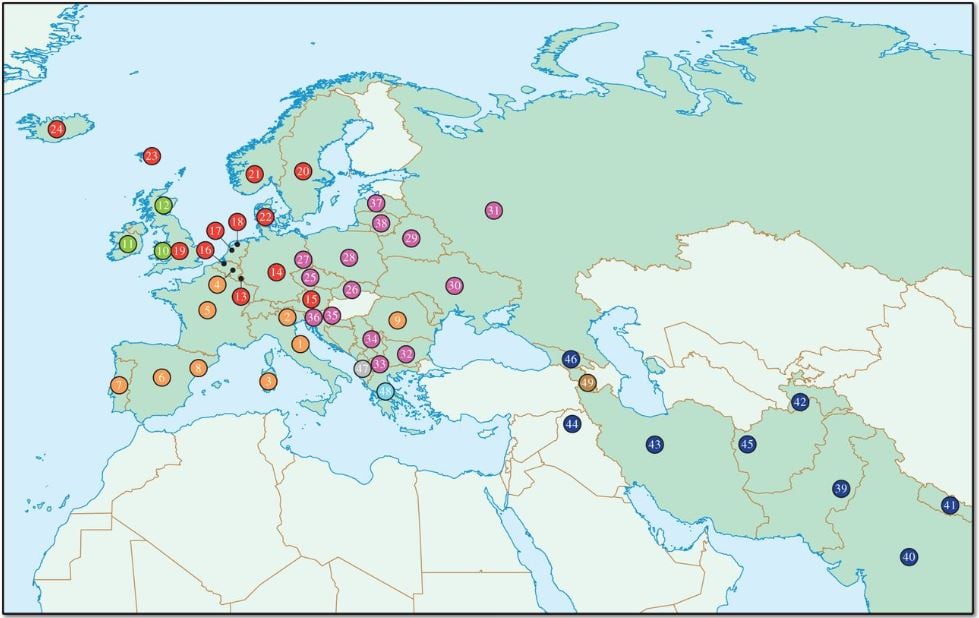Most fairy tales, such as Rumpelstiltskin, Jack and the Beanstalk and Beauty and the Beast, are between four and six thousand years old, predating the Bible and Roman and Greek mythology, say two researchers from England and Portugal.
Sara Graça da Silva, from the New University of Lisbon (Universidade Nova de Lisboa) in Portugal, and Jamshid J. Tehrani, from Durham University in England, explained in the journal Royal Society Open Science that popular fairy tales probably influenced the themes in Greek and Roman mythology, the Bible, and a number of other religious works.
Most previous research and current scholars have said that popular fairy tales originated much more recently.
 Approximate locations of Indo-European-speaking populations in Eurasia. Points are colour-coded by linguistic subfamily: green, Celtic; red, Germanic; pink, Balto-Slavic; blue, Indo-Iranian; orange, Romance; Turquoise, Hellenic; grey, Albanian; brown, Armenian. (Image: Royal Society Open Science)
Approximate locations of Indo-European-speaking populations in Eurasia. Points are colour-coded by linguistic subfamily: green, Celtic; red, Germanic; pink, Balto-Slavic; blue, Indo-Iranian; orange, Romance; Turquoise, Hellenic; grey, Albanian; brown, Armenian. (Image: Royal Society Open Science)
Many folktales told in extinct ancestral tongues
Dr. Jamie Terhrani, Senior Lecturer at the Department of Anthology, believes versions of Rumpelstiltskin, Beauty and the Beast and Jack and the Beanstalk have been told to children since before the majority of European languages ever existed.
Over seventy fairy tales were told in ancestral languages, from which modern European languages evolved.
Dr. Tehrani said:
“It is difficult to put precise dates on such things, but we’re looking in the region of 4,000 to 6,000 years old.”
Dr. Sara Graça da Silva, Postdoctoral Researcher at the Institute for Studies of Traditional Literature, Faculty of Human and Social Sciences, and Dr. Tehrani, studied 275 Indo-European fairy tales. They wanted to determine whether closely-related communities were more likely to share them than distantly-related ones.
The majority of languages in India, the Middle-East and India descend from a common ancestral language which scholars call proto-Indo-European. While English is very different from Hindi, for example, they both ultimately originate from the same source – Indo-European.
 Jack and the Beanstalk has been around since before the Bible was written.
Jack and the Beanstalk has been around since before the Bible was written.
Languages with common origins versus geographical proximity
They tried to establish whether it is possible to predict how often folktales are shared depending on how related communities’ languages are versus how physically (geographically) close they are to each other.
Do Portuguese and Romanian communities, which both speak Romance languages, share more fairy tales than Romanian and Ukrainian communities. Romania and Ukraine are neighbours, but Ukrainian is an East Slavic language.
This allowed them to filter out fairy tales that make their way to neighbouring towns – through trade or migration – from those that came from the root language of related modern languages.
Of the 275 folktales they studied, seventy-six came from a common ancestral language.
They then mapped those tales on a family tree of Indo-European languages to see how far back they could trace them.
They applied techniques used by biologists to reconstruct the evolution of genetically-inherited features – known as comparative phylogenetic methods.
According to medicinenet.com, Phylogenetics is:
“The study of the relationships between organisms based on how closely they are related to each other. In phylogenetics, the most convenient way of visually presenting evolutionary relationships among a group of organisms is through illustrations called phylogenetic trees.”
An ultra-ancient folktale – The Smith and the Devil
One of the oldest tales that is still told to children today is A Dialogue between Joseph Smith and the Devil (The Smith and the Devil). A blacksmith called Joseph sells his soul to the devil or an evil spirit, and in return is given the power to weld materials together. He then uses his new superpower to weld the evil spirit to a tree, and says he will only free it if he gets his soul back.
According to Dr. Tehrani, The Smith and the Devil can be traced by to the Bronze Age ancestral languages of the Indo-European family of languages.
In the Journal’s article, the authors wrote:
“Anthropologists have long speculated that folktales may preserve other kinds of information about the ancestral contexts in which they originated, such as social organization, subsistence practices and religion. Comparative phylogenetic methods provide a powerful set of tools with which to investigate these hypotheses more scientifically.”
“We anticipate that future studies in this area will not only shed new light on the origins of fairy tales, myths, legends and other types of traditional narrative, but also offer novel and complementary perspectives on archaeological, genetic and linguistic reconstructions of the past.”
Reference: “Comparative phylogenetic analyses uncover the ancient roots of Indo-European folktales,” Jamshid J. Tehrani and Sara Graça da Silva. Royal Society Open Science. 14 January 2016.DOI: 10.1098/rsos.150645.

